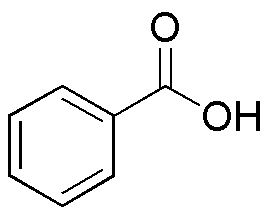Benzoic acid is widely utilized in research focused on:
- Food Preservation: Commonly used as a preservative in food products to inhibit the growth of mold, yeast, and some bacteria, thereby extending shelf life.
- Pharmaceuticals: Acts as a key ingredient in various medications, particularly in topical treatments and as a pH adjuster in formulations, enhancing drug stability and efficacy.
- Cosmetics: Employed in cosmetic formulations for its antimicrobial properties, helping to maintain product integrity and safety for consumers.
- Industrial Applications: Utilized in the production of plastics, dyes, and perfumes, where it serves as a building block for synthesizing more complex compounds.
- Research and Development: A vital reagent in organic synthesis and chemical research, facilitating the study of reaction mechanisms and the development of new materials.
General Information
Properties
Safety and Regulations
Applications
Benzoic acid is widely utilized in research focused on:
- Food Preservation: Commonly used as a preservative in food products to inhibit the growth of mold, yeast, and some bacteria, thereby extending shelf life.
- Pharmaceuticals: Acts as a key ingredient in various medications, particularly in topical treatments and as a pH adjuster in formulations, enhancing drug stability and efficacy.
- Cosmetics: Employed in cosmetic formulations for its antimicrobial properties, helping to maintain product integrity and safety for consumers.
- Industrial Applications: Utilized in the production of plastics, dyes, and perfumes, where it serves as a building block for synthesizing more complex compounds.
- Research and Development: A vital reagent in organic synthesis and chemical research, facilitating the study of reaction mechanisms and the development of new materials.
Documents
Safety Data Sheets (SDS)
The SDS provides comprehensive safety information on handling, storage, and disposal of the product.
Product Specification (PS)
The PS provides a comprehensive breakdown of the product’s properties, including chemical composition, physical state, purity, and storage requirements. It also details acceptable quality ranges and the product's intended applications.
Certificates of Analysis (COA)
Search for Certificates of Analysis (COA) by entering the products Lot Number. Lot and Batch Numbers can be found on a product’s label following the words ‘Lot’ or ‘Batch’.
*Catalog Number
*Lot Number
Certificates Of Origin (COO)
This COO confirms the country where the product was manufactured, and also details the materials and components used in it and whether it is derived from natural, synthetic, or other specific sources. This certificate may be required for customs, trade, and regulatory compliance.
*Catalog Number
*Lot Number
Safety Data Sheets (SDS)
The SDS provides comprehensive safety information on handling, storage, and disposal of the product.
DownloadProduct Specification (PS)
The PS provides a comprehensive breakdown of the product’s properties, including chemical composition, physical state, purity, and storage requirements. It also details acceptable quality ranges and the product's intended applications.
DownloadCertificates of Analysis (COA)
Search for Certificates of Analysis (COA) by entering the products Lot Number. Lot and Batch Numbers can be found on a product’s label following the words ‘Lot’ or ‘Batch’.
*Catalog Number
*Lot Number
Certificates Of Origin (COO)
This COO confirms the country where the product was manufactured, and also details the materials and components used in it and whether it is derived from natural, synthetic, or other specific sources. This certificate may be required for customs, trade, and regulatory compliance.


